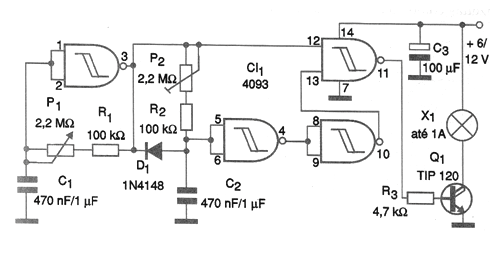The circuit shown in the figure can either be used to activate a high-power lamp or LED for signaling, but also for intermittent action automatisms in which both the frequency and the active cycle must be adjusted separately. The circuit consists of a sturdy one built around a 4093 NAND gate where the frequency depends on C1 and the setting of P1. The signal from this rectangular oscillator is applied to a monostable built around a second door, which is triggered by the first and thereby determines the pulse duration. The time adjustment is made in P2 and basically depends on the value of C2. Both C1 and C2 can have their values modified according to the application given to the circuit. Limit values are around 1 500 uF, which leads to a maximum delay close to 1 hour. The signals from the two ports are combined into a third that acts as a digital amplifier, exciting a power Darlington transistor. This transistor directly feeds the load that can be either a lamp or another device (relay, solenoid, motor or even high-brightness LED). The feed basically depends on the type of load to be fed. The circuit works with voltages from 5 to 12 V and its consumption is very low when the load is not activated.




